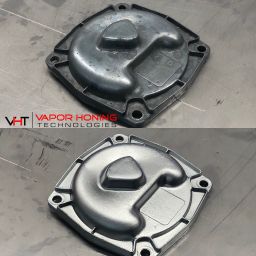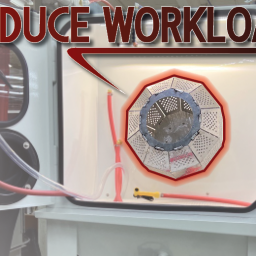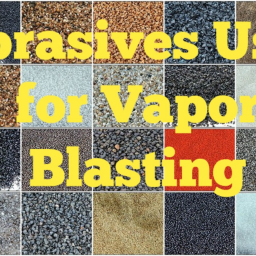Vapor Honing an Engine: The Ultimate Guide
Imagine you just bought an old motorcycle that runs well and looks amazing. However, the engine doesn’t look so good, and you decide to clean it.
Before you use just any cleanser, consider vapor honing an engine. That way, you can restore the engine without damaging it.
Keep reading to learn more about vapor honing technologies.
What Is Vapor Honing?
Vapor honing goes by many names, such as vapor blasting or wet blasting. No matter what you call it, the technology cleans and finishes surfaces. It involves combining water with an abrasive material and blasting the engine with the combination.
The mix becomes pressurized as you blast it, so it can better clean and finish the surface of the engine. That way, it can get the engine even cleaner and shinier than before. The technology is an excellent alternative to other cleaning and finishing methods.
It’s similar to dry blasting, but there are some benefits, such as getting surfaces cleaner more easily. The technology can also clean surfaces evenly, so you don’t have to worry as much about touch-ups.
Why Use Vapor Honing on an Engine?
If you need to clean or refinish an engine, vapor honing technologies are a great choice. The technology is especially helpful when it comes to restoring old motorcycle engines. Using a technology like dry blasting can be too harsh and can remove marks and traits of the engine.
That can decrease the resale value if you plan to sell it. And if not, it can change the way the engine looks. Vapor honing is a much better method for cleaning and refinishing older engines.
You don’t need to use any chemicals or disposals, and you can prepare the engine surface for a new coating. Vapor honing on an engine can also reduce the amount of dust involved when cleaning the engine.
It cleans by flow instead of impact, and you can blast and de-grease surfaces in one step. You can also use finer abrasives without ruining the engine.
Best Abrasives to Use
When vapor honing on an engine, you should consider what abrasives you can use. An abrasive is a material with hard crystals that come from nature or manufacturing. Examples include aluminum oxide, garnet, glass, and even diamonds.
The best abrasives for your needs can depend on how smooth or rough you want the final surface to be. They can penetrate metals and alloys to get the surface as clean and shiny as you need.
You should consider how you want the engine to look when choosing the right vapor honing technologies. That way, you can choose the best abrasive for the job.
Round Media
Round media include abrasives with round surfaces, and they can be a great option for cleaning and brightening an engine. You can use vapor honing to descale surfaces with round media as well.
Examples in this category include glass beads, ceramic materials, and a stainless steel shot. Glass is about in the middle of the Mohs hardness scale, at about 4.5 to 6.5 out of 10. That means glass balls can be a good abrasive without being too harsh.
Steel is a little harder, with a rating of 5 to 8.5 on the Mohs scale. The hardness of ceramic can depend on the ceramic material and the size, but it’s a good starting material as well.
Plastic Angular Media
Plastic angular media is another type of abrasive, and you can use these abrasives for paint stripping. You can also use them to deflash plastic parts and to remove types of flash. These abrasives work especially well in a system that starts with a wet abrasive followed by blasting just water.
Then, you can follow it up with a drier to clean the engine. Because the media is plastic, it’s a lot softer than other abrasives, so it’s good if the engine material is softer or if you don’t need as thorough of a clean.
Using small pieces of plastic to clean and finish a surface can be a great choice for your first time with DIY vapor honing on your own machine. You don’t have to worry about being too rough on the material, and you can switch to a different medium if necessary.
Angular Grit Media
While plastic angular media is softer, angular grit media is harder. It’s the perfect choice for blasting hardened surfaces that have a lot of rust or other issues. You can also use it to remove grease and surfaces with a lot of scaling.
Examples of angular grit media include steel grit, crushed glass, silicon carbide, and aluminum oxide. As mentioned, steel and glass are in the middle of the Mohs scale, so they have about average hardness. Aluminum oxide has a rating of 9, and silicon carbide’s rating is 9.2.
Both of those materials can remove a lot of scale and dirt, and they’re some of the hardest materials out there. If you’ve tried other vapor honing mediums that haven’t worked, try aluminum oxide or silicon carbide.
Fine Angular Grit Media
A subsection of angular grit media, fin angular grit media doesn’t have a different hardness range. But the media is smaller and can get deep into the surface of an engine to clean and finish it.
Fine angular grit media is a great option for cleaning or de-scaling pores of surfaces. That can help you prepare the surface for coating or just to use as is.
However, fine media may not be the best option for smoother surfaces. You don’t need to use as harsh of an abrasive, so you can save it for the engines that do require something serious.
Vapor Honing Applications
Vapor honing on an engine has multiple applications. While it all revolves around an engine, you can do more than just clean and finish the engine or engine parts.
Depending on the abrasive you use, you can get as detailed as you want when vapor honing. Whether you want to clean a motorcycle engine that you own or revitalize an industrial engine, you can use vapor honing.
While you should consider factors like the vapor honing cabinet cost, you want to make sure you use the best method for the engine. Consider how you can apply vapor honing on an engine.
Cleaning
If you’ve ever struggled to clean an engine, you’re not alone. Spending time wiping down an engine can be annoying, especially if you have multiple engines that you need to clean.
Vapor honing on an engine can save you a lot of time. You can blast the engines and get them clean without having to scrub every nook and cranny. If you have a lot of hardened surfaces, you can even choose a more abrasive material that won’t require more time to blast.
Even if you don’t have a ton of residue, vapor honing an engine can still be an efficient way to clean and maintain your equipment. Then, you won’t have to use harsher abrasives as much.
Coating Prep
While coating an engine may not be common, it’s an option. If you want to paint your engine, you should use vapor honing first so that you can prepare the surface. Vapor honing an engine will get rid of anything on the surface, visible or not.
If you try to clean it yourself, you may miss smaller particles that are stuck on the engine. Then, the new paint coat may not stick on the engine as well, so you would need to vapor blast it again and repeat the whole process.
But vapor honing an engine that has paint already can also help. You can use the blast to strip the engine of any paint, so you can start from scratch.
Manufacturing
If you need to manufacture engines, you can also use vapor honing. Vapor honing an engine that you manufacture can make it look the best it can when it comes time to sell it.
While engines don’t have to look pretty all of the time, it can be easier to sell one that looks clean and shiny. Some people believe the natural preference for a glossy surface is instinctual. One theory is that there’s a link between glossy surfaces and the need to drink water.
More research needs to happen, but it does show that people prefer glossier looks. If you can use vapor honing to achieve that, you can sell engines more easily.
Restoration
If you have an old engine, you don’t have to throw it out just because of its looks or age. You can restore it mechanically with a new battery or other engine parts. And you can do the same to the exterior with vapor honing.
Using the right abrasives with vapor honing can make your old engine look like new. You can save a lot of money on replacing it, and you can still get a good experience from it.
Whether or not you sell engines, being able to restore them can be thrilling. That way, you can extend their lifespan and enjoy your old ride for longer.
Benefits of Vapor Honing
If you’re considering vapor honing vs sandblasting or something similar, you may want to know about the benefits. There are multiple benefits of vapor honing over sandblasting or other methods.
Whether you need to blast things regularly or on occasion, you should always choose the best method. While those other processes can work, they aren’t as precise or gentle as vapor honing.
Before you choose the right method for your next task, consider a few benefits of vapor honing an engine.
Finer Finish on Surfaces
Vapor honing an engine can lead to a finer finish on surfaces. The technology allows you to choose the best abrasive for the job, so you can get as detailed as you want. If you have something soft to clean, you can use plastic angular media.
But if you want to get a really fine finish, you can opt for fine angular media. Or you can choose something in between, like angular grit media or round media.
No matter what medium you choose, the addition of water can help the medium stick to the surface to clean and polish it. Then, you can make sure you clean it as well as possible.
Gentler Than Dry Blasting
Vapor honing, also known as wet blasting, is a gentler option than dry blasting. The two methods are almost the same, except for the use of water in vapor honing. Adding water helps protect surfaces from the abrasives, so they aren’t as harsh as they could be.
The water can dampen the surface and act as a cushion. Abrasives can still get to the surface and do their job, but you can use it on softer engine surfaces.
When you take away the water, the abrasives will be as harsh as they can. In some cases, that can help you clean your engine if there is a lot of buildup. However, it does take a toll on your engine.
Cost-Effective
Another benefit of vapor honing an engine is that it’s more affordable than some options. For one, it reduces the consumption of abrasives, so you can make them last longer or use them on more engines.
The water can also lower the amount of dust emissions around the machine. That can keep your air cleaner and help you breathe more easily. You don’t even need a ton of water for it to be effective in this way.
Safe
Because it traps dust and doesn’t require as many abrasives, vapor honing an engine is also safer. You can do it inside in a controlled environment, and you don’t need a ton of personal protective equipment (PPE).
It can also keep you safe from dust fires by collecting the dust. You can use vapor honing as much as you like to clean and finish your engines, and you don’t have to worry about safety as much.
Vapor Honing an Engine
Vapor honing an engine is an excellent way to clean and finish a new engine or restore an old one. While you can use other methods for cleaning, they can be harsher and less effective.
Whether you have one engine you need to clean or multiple, consider vapor honing. Then, you can have the engine looking good in no time.
Are you ready to start vapor honing an engine? Buy vapor honing equipment today.








